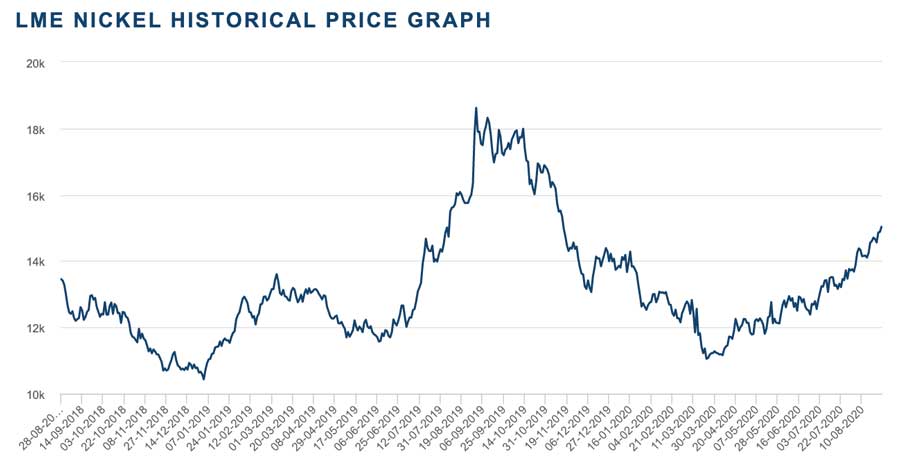Elon Musk, Indonesian issues will help Australia become a leading nickel player

Pic: Bloomberg Creative / Bloomberg Creative Photos via Getty Images
While headlines have been largely dominated by gold and silver, nickel is making moves — and Australian companies are vying for a leading position in the market.
After hitting a record $US18,620 ($25,747) a tonne last year, nickel promptly crashed back to earth. But the tide has now turned following the COVID-19 market bottom in March and nickel has since climbed 36 per cent to $US15,034.

BHP (ASX:BHP) recently said LME nickel prices had traced a ‘V shape’ over the last four months, first falling heavily as COVID–19 escalated in developed markets, and then rallying strongly in line with other base metals and pro-growth assets.
A key sign of nickel’s potential has been moves by the world’s second largest miner to ramp up its market share.
Once an unloved and underperforming asset in the BHP stable, the Nickel West operation is now a key focus for the major.
Nickel West president Eddy Haegel last year called it a “once-in-a-generation opportunity”, saying the company isn’t wasting time waiting for the boom to hit.
While nickel’s main use is in the stainless steel sector, which accounts for more than two-thirds of primary demand at the moment, BHP sees the battery and stainless steel markets eventually being on equal footing.
“With a rapid and prolonged drive towards the electrification of transport in prospect, we contend that there are plausible long run paths where batteries and stainless steel will become equally important consumers of nickel, in a much bigger global market,” the mining heavyweight says.
The Elon Musk/Tesla effect
In late July, Elon Musk gave nickel a boost by calling on miners to produce more of the stuff.
“Obviously Elon Musk’s comments around nickel have spurred on nickel and re-emphasised its importance in stainless steel and obviously in electric cars,” Guy Le Page, director and responsible executive at Perth-based financial services provider RM Corporate Finance, told Stockhead recently.
“So thanks to Elon for that little kick along.”
But a big call from a major player like Musk is not exactly quantifiable, according to one expert.
“I would argue that it is hard to quantify the direct impact of Elon’s calls on the market, apart from perhaps helping to drive an uptick in the nickel price in recent weeks,” Benchmark Mineral Intelligence analyst Gregory Miller told Stockhead.
“Elon’s calls have certainly drawn the attention of the wider EV (electric vehicle) industry to sustainability concerns associated with nickel mining, however these were not a new concern for OEM’s (original equipment manufacturers) and cell producers.
“A waste spill at the Ramu mine in Papua New Guinea last year, a mine that utilises deep sea tailings for waste disposal, drew the attention of end users in the battery supply chain to the ESG (environmental, social and governance) risks associated with some HPAL (high pressure acid leach) projects.”
Highly capital-intensive processing bad news for Indonesia
Miller said the majority of supply growth over the coming decade was set to come from laterite ores, specifically from Indonesia.
But producing nickel intermediates and/or nickel sulphate for the battery industry from laterite ores, via HPAL, is highly capital intensive and challenging from a production standpoint.
A number of current HPAL operations have struggled to hit nameplate capacity, and also generate large quantities of waste, he says.
But Indonesia’s ongoing ban on exporting raw nickel ore has forced miners to go down the processing path.
“At present, the Indonesian HPAL projects under construction are exploring deep sea tailings or tailings dams as their principal means of waste disposal, and there are numerous ESG risks associated with both approaches,” Miller explained.
“Whilst it is possible to produce nickel in an environmentally sensitive manner, typically by backfilling the pits, it will come at a price and will require further cost increases at mines that are already very capital intensive.”
Now that’s a problem for OEMs, because there is an increasing shift towards more nickel intensive cathodes, meaning the commodity will become a larger share of the overall cost.
Meanwhile, the increasing focus on ESG throughout the battery supply chain will push end users to suppliers that can demonstrate their production is ethical and sustainable.
“Ultimately, sustainability concerns will likely drive consumer competition for supply from other countries, from mines which are deemed ‘cleaner’, however there certainly will not be sufficient supply to meet the ramp up of demand from the battery industry over the coming decade without Indonesian HPAL,” Miller noted.
Not enough nickel supply
Miller says there are several operations that are currently switching production to nickel sulphate, the battery chemical of choice for EV cells, most notably BHP Nickel West and Finland’s Terrafame. This can help satisfy demand over the coming two to five years.
At the same time lower cost nickel pig iron supply is increasingly displacing class 1 nickel from the stainless steel industry, which Miller says frees up nickel units for the battery industry and will increase the availability of supply from more ‘sustainable’ mines.
“However, the volumes would be not be significant enough to meet the rapid growth in demand for nickel from the battery industry post 2025,” he says.
“There are also several nickel projects in the development stage that are targeting supplying the battery industry, particularly in North America and Australia, which can potentially help provide alternative supply sources to the EV industry.
“However, as with all development stage projects, the timeline to production is many years (seven or more on average), and it remains uncertain as to whether they will come online.
“If end users are looking to source nickel outside of Indonesia for their long-term supply, they will likely have to pay a premium for this material.”
Benchmark expects batteries to take a significant market share from 2023.
“We see nickel demand from lithium-ion batteries reaching 2,250,000 tonnes by 2035,” Miller told Stockhead previously.
RM Corporate’s Le Page says while the market is well supplied now, the medium to longer term outlook is more promising.
“We’ve seen a lot of strength in nickel,” he said. “Interestingly if you look at the China nickel supply, there’s a lot more coming from nickel pig iron imports (NPI) from Indonesia.
“That increased from about 354,000 to 540,000 tonnes this financial year. So I think while the market is temporarily in surplus, the medium-term outlook looks pretty strong.
“So that bodes well for our nickel players here, of which there are very few to invest in.”
High quality Australian nickel projects in the pipeline
St George Mining (ASX:SGQ) revealed on Thursday recent drilling at its flagship Mt Alexander project in the north-eastern goldfields of Western Australia had hit a 48.7m thick mafic-ultramafic unit hosting nickel and copper sulphide mineralisation from a depth of 503m.
Two drill holes were completed at the Investigators and Fairbridge prospects.
“A very important aspect of this discovery is the preserved nature of the 48m thick unit intersected at Investigators,” managing director John Prineas said.
“This significantly increases the potential likelihood for the presence of larger accumulations of nickel-copper mineralisation nearby.”
St George is working towards defining a resource at one of the many high-grade and near-surface nickel discoveries it has made along the Cathedrals Belt at Mt Alexander, as a precursor to establishing a “starter’’ mining operation.
Azure Minerals (ASX:AZS) has just kicked off exploration at its Andover nickel-copper project in the West Pilbara region of WA.
The company announced yesterday a ground electromagnetic survey was underway to identify nickel sulphide mineralisation.
Work by renowned prospector Mark Creasy over the past 12 years has firmed up Andover’s ‘company making’ potential, with surveys and sampling cumulating in a 2018 drilling program that hit nickel and copper mineralisation in three out of four targets.
“Since announcing this acquisition, our shareholders have expressed significant support for the project and our reasoning in coming back to Western Australia,” managing director Tony Rovira said.
Azure has already secured environmental approvals for reverse circulation and diamond drilling.
“It is an advanced stage exploration project and that is why we have planned a very intensive drilling campaign including a 3,000m diamond drilling program that will begin in mid-September and about 5,000m of reverse circulation drilling to be done next year,” Rovira told Stockhead.
Azure reached an agreement in mid-July to acquire 60 per cent of the 70sqkm Andover project from the Creasy Group in return for a free carry on the remaining 40 per cent interest until the execution of a mining joint venture agreement.
The deal also makes Mark Creasy one of the two biggest shareholders in the company.
St George (ASX:SGQ) and Azure Minerals (ASX:AZS share price chart
Navigating new frontiers
Rox Resources (ASX:RXL) is also on the hunt for WA nickel, and may have made a “frontier-type” discovery in a previously unexplored belt parallel to the highly prospective Yilgarn Craton.
The company revealed in June that it had pinpointed five new nickel sulphide targets during regional exploration at the Mt Fisher project in WA.
This new, completely untested belt has been discovered parallel to the Yilgarn Craton, a large mineral-rich region around 400km east of Perth in WA that has spawned numerous major mines over the past few centuries and has been described as “Australia’s premier gold and nickel province”.
This belt sits adjacent to Rox’s nickel rich Mt Fisher belt and its joint venture ground with Cullen Resources’ (ASX:CUV), located in the Northern Goldfields, about 600km northeast of Kalgoorlie.
Until recently, the northern part of the Mt Fisher greenstone belt was interpreted by the Geological Survey of Western Australia to abut the margin of the Yilgarn Craton with a northerly strike bound by granite to the west and east.
Poseidon Nickel (ASX:POS) owns the Lake Johnston, Mt Windarra and Black Swan projects in WA.
Lake Johnston is a near-term production project, while Mt Windarra is ready for development following extensive engineering, drilling and refurbishment.
Black Swan, meanwhile, hosts a nickel sulphide open pit and process plant which Poseidon expects to reopen.
The company announced last week it had hit high-grade massive sulphide mineralisation at its Golden Swan deposit, which sits adjacent to the Black Swan prospect.
Le Page says Golden Swan looks like a repeat of the neighbouring Silver Swan deposit.
Estrella Resources (ASX:ESR) has nickel projects further to the north of Poseidon.
The company picked up an unloved project called Carr Boyd, north of Kalgoorlie, back in 2017. It was a past producing mine that was discovered in the late 1960s and mined by Great Boulder Mines and WMC from the early to late 70s.
Carr Boyd is similar geology to Nova-Bollinger in the Fraser Range, the famous discovery that rocketed explorer Sirius Resources from penny stock to $1.8bn takeover target in just three years.
Modern geophysics or any meaningful exploration has been practically non-existent for over 20 years.
The focus for Estrella is the T5 target, where the company hit 11m of a mineralised basal contact zone.
The mineralisation extends over 400m strike and is open to the north, south and at depth.
RXL, POS and ESR share price charts
At Stockhead, we tell it like it is. While Azure Minerals and Rox Resources are Stockhead advertisers, they did not sponsor this article.
Related Topics
UNLOCK INSIGHTS
Discover the untold stories of emerging ASX stocks.
Daily news and expert analysis, it's free to subscribe.
By proceeding, you confirm you understand that we handle personal information in accordance with our Privacy Policy.








